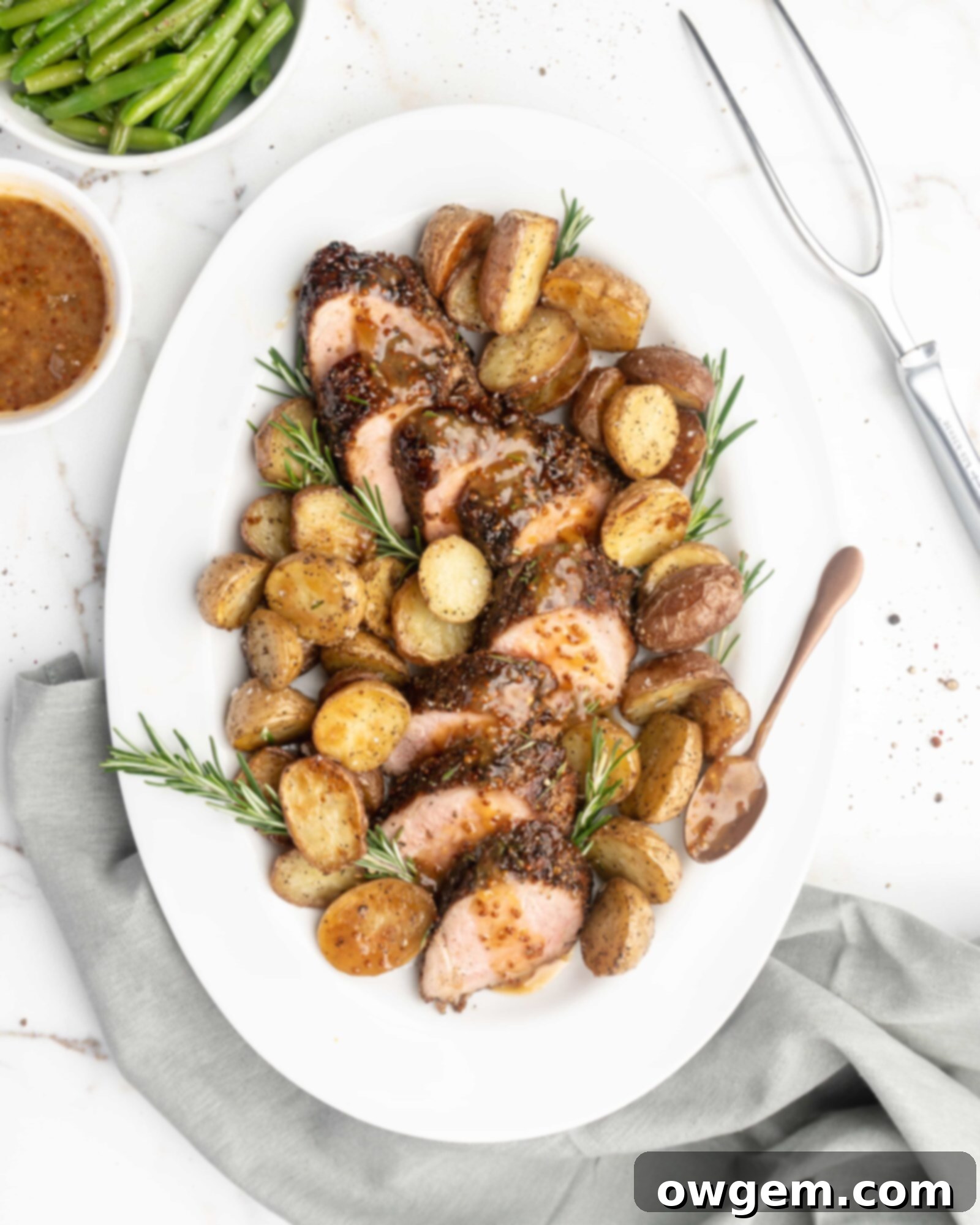Sweet & Savory Rosemary Peach Mustard Glazed Pork Tenderloin: An Easy, Flavorful Recipe
Prepare to elevate your weeknight dinner rotation with this incredibly simple yet profoundly flavorful recipe for Pork Tenderloin with Rosemary Peach Mustard. This dish proves that gourmet taste doesn’t require a complex ingredient list or hours in the kitchen. We start with lean, tender pork tenderloin, perfectly seared in a hot pan to develop an irresistible golden-brown crust and lock in all those magnificent savory flavors. The magic truly begins when it’s generously glazed with our signature Rosemary Peach Mustard – a vibrant, five-ingredient sauce bursting with sweet, tangy, and aromatic notes from peach jam, grainy mustard, Dijon mustard, fresh rosemary, and bright lemon zest. After a quick glaze, the pork finishes cooking in the oven for just about 20 minutes, ensuring it remains wonderfully moist and tender. It’s truly as easy as it sounds! For an extra burst of that delightful sweet and tangy goodness that complements pork so beautifully, be sure to serve each slice with an additional dollop of the luscious Peach Mustard. This recipe is designed to impress with minimal effort, making it ideal for both busy evenings and special occasions.
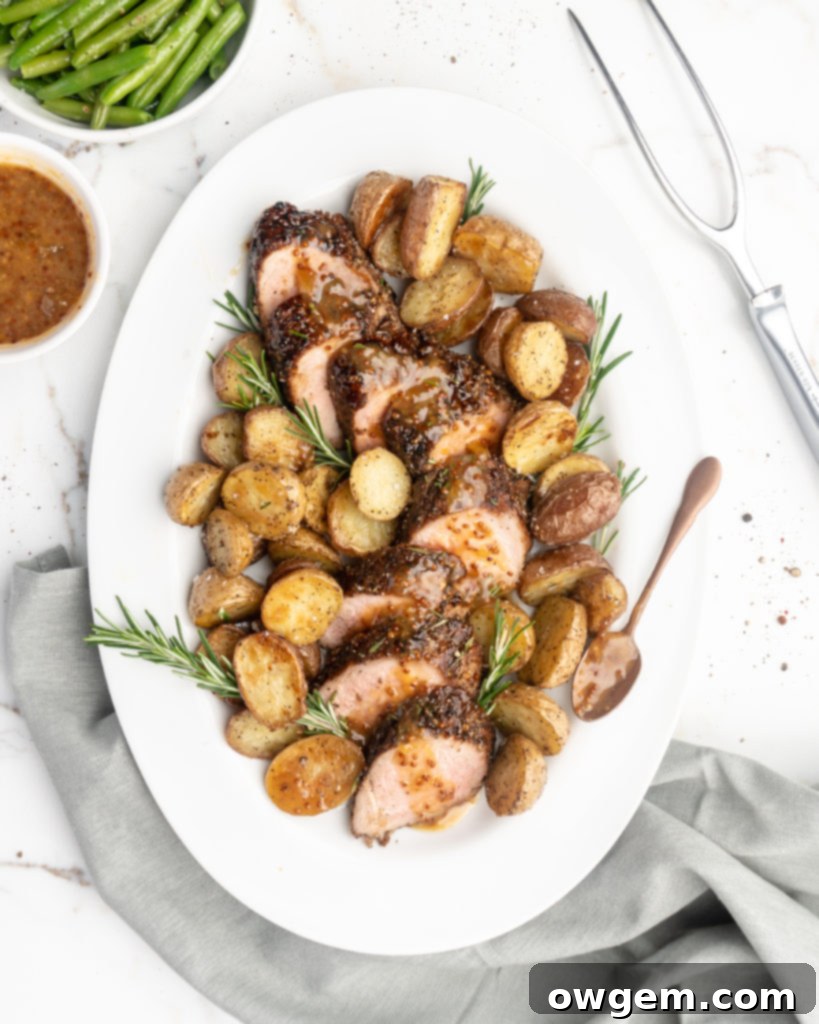
Crafting the Irresistible Rosemary Peach Mustard Glaze
As highlighted, the star of this dish, alongside the perfectly cooked pork, is undoubtedly the Rosemary Peach Mustard glaze. This exceptional sauce boasts incredible depth of flavor from just five simple ingredients: luscious peach jam, robust grainy mustard, sharp Dijon mustard, fragrant fresh rosemary, and invigorating lemon zest. There’s no need for an extensive list of obscure ingredients or complicated techniques to achieve a spectacular sauce when these humble components come together in such perfect harmony. This glaze doesn’t just complement the pork tenderloin; it truly transforms it, adding layers of sweet, tangy, and herbaceous notes that are simply irresistible.
Making this flavorful Rosemary Peach Mustard is remarkably straightforward. Begin by combining the peach jam, both types of mustard (grainy and Dijon), and the bright lemon zest in a small bowl. Whisk these ingredients together until they are thoroughly combined and smooth. Next, spoon approximately one-third of this mixture into a separate bowl. To this smaller portion, add the finely chopped fresh rosemary. This rosemary-infused segment is what you’ll use to generously glaze your beautifully seared pork tenderloins before they go into the oven to finish cooking. The remaining two-thirds of the peach mustard, without the rosemary, will be reserved and served alongside the finished pork, allowing its pure sweet-tangy essence to shine as a delightful accompaniment. This two-stage approach ensures the rosemary’s aroma subtly infuses the glaze during cooking, while the fresh, unadulterated peach mustard provides a vibrant counterpoint at the table.
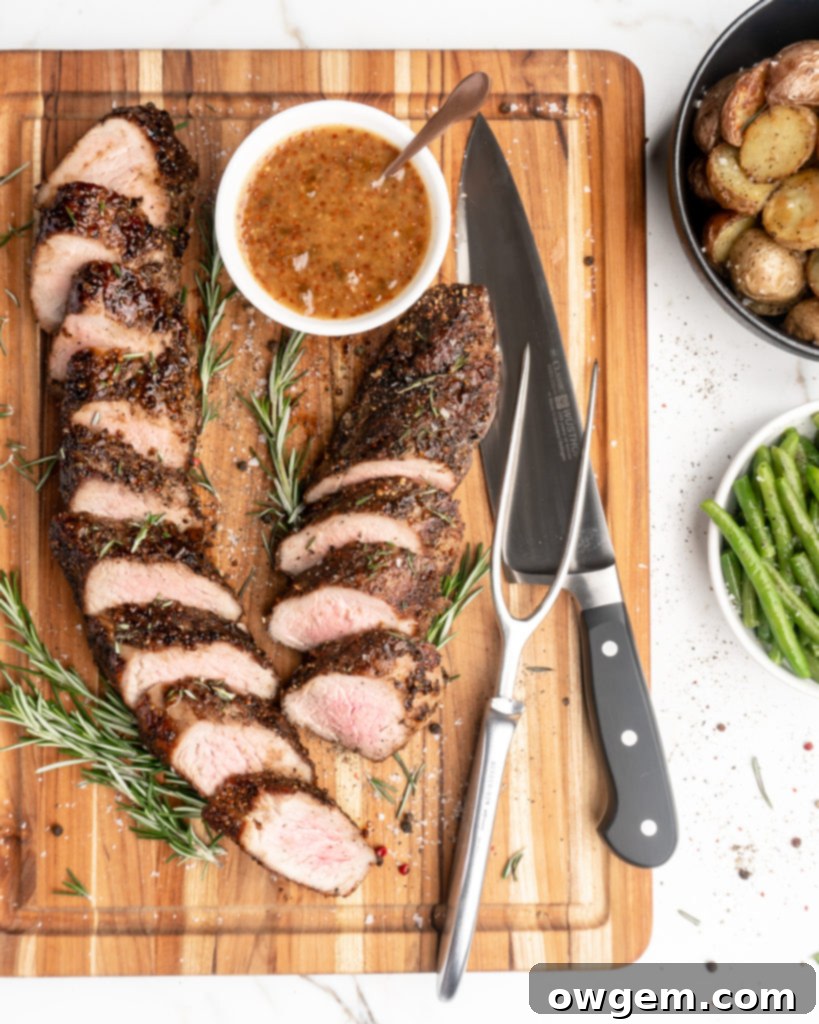
Understanding Pork Tenderloin: A Lean and Tender Cut
Pork tenderloin is often considered the pork equivalent of beef tenderloin – and for good reason! This prized cut comes from a muscle along the pig’s spine that is primarily used for posture rather than heavy movement. Because it sees very little exertion, the pork tenderloin is exceptionally tender, boasting minimal connective tissue and a delicate, fine grain. It’s also remarkably lean, making it an excellent, healthier alternative to chicken breast for those seeking lean protein options. Its mild flavor and tender texture make it a versatile canvas for a wide array of seasonings and sauces.
However, with its leanness comes a particular culinary challenge: the lack of fat, while great for health, often translates to a lack of inherent, robust flavor. This is why it is absolutely imperative to pair pork tenderloin with bold, assertive flavors that can truly enhance and elevate its mild character. These flavors can manifest in numerous forms, from spicy rubs and aromatic herb blends to vibrant sweet-tangy glazes – precisely like the delicious rosemary peach mustard featured in this particular pork tenderloin recipe. When selecting your pork tenderloin, look for a uniform pink color and trim any silverskin, a thin, iridescent membrane, as it can become tough when cooked and prevents the meat from absorbing flavors. Proper preparation and thoughtful flavor pairings are key to transforming this lean cut into an extraordinary meal.
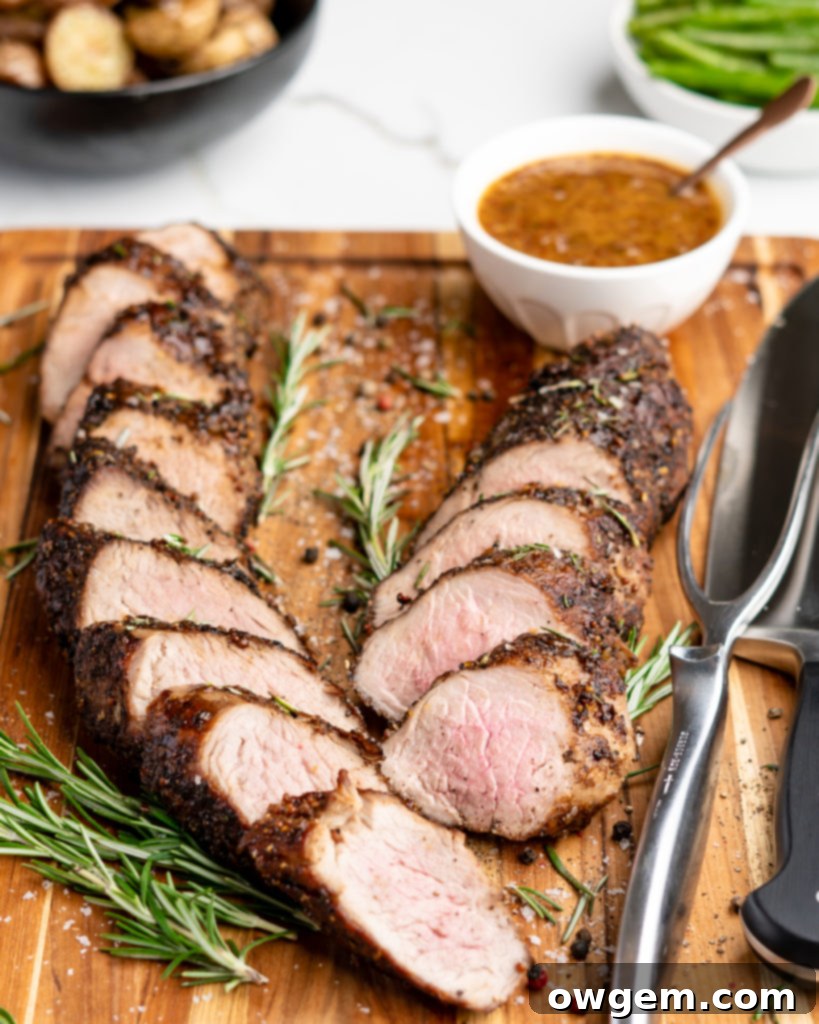
Mastering the Cook: How to Achieve Perfectly Juicy Pork Tenderloin
Given the lean nature of pork tenderloin, it thrives under short, high-heat cooking methods. Prolonged cooking would simply strip the pork of its precious moisture, resulting in a dry and unappetizing dish. This recipe employs a superior cooking method that marries the best of both worlds: searing on the stovetop followed by a quick finish in the oven. This technique ensures a tender, juicy interior and a beautifully caramelized exterior.
The initial searing step is crucial. By placing the pork tenderloin in a hot, heavy skillet with a touch of oil, we trigger the Maillard reaction – a complex chemical process responsible for those amazing savory flavors and the appealing brown crust on cooked food. This browning not only adds incredible depth of flavor, which is much needed for a lean cut like pork tenderloin, but it also creates a delectable texture contrast. After a thorough sear on all sides, the pork tenderloin is then transferred to a preheated oven for a short period, typically around 20 minutes, to finish cooking gently and evenly. The benefits of this sear-then-roast method are twofold: firstly, it develops unparalleled flavor through browning, and secondly, finishing the pork tenderloin in the oven allows the meat to retain as much moisture as possible, preventing that dreaded dry pork outcome. Remember, nothing is worse than a perfectly seasoned but arid piece of pork!
Another vital point to understand for perfectly cooked pork is that it absolutely does not need to be cooked until it’s “white throughout.” In fact, for optimal moisture and tenderness, there should be just a touch of delicate pink remaining in the very center of the pork tenderloin. The USDA recommends cooking pork to an internal temperature of 145°F (63°C), as measured with a reliable meat thermometer inserted into the thickest part of the meat. This internal temperature, when followed by a crucial 5-minute resting period, ensures the pork is safe to eat while remaining incredibly moist, tender, and flavorful. The resting period allows the juices within the meat to redistribute, ensuring every bite is succulent. Slicing too soon will cause those precious juices to run out, leading to a drier result. Trust the thermometer, allow for the rest, and you’ll achieve pork tenderloin perfection every time.
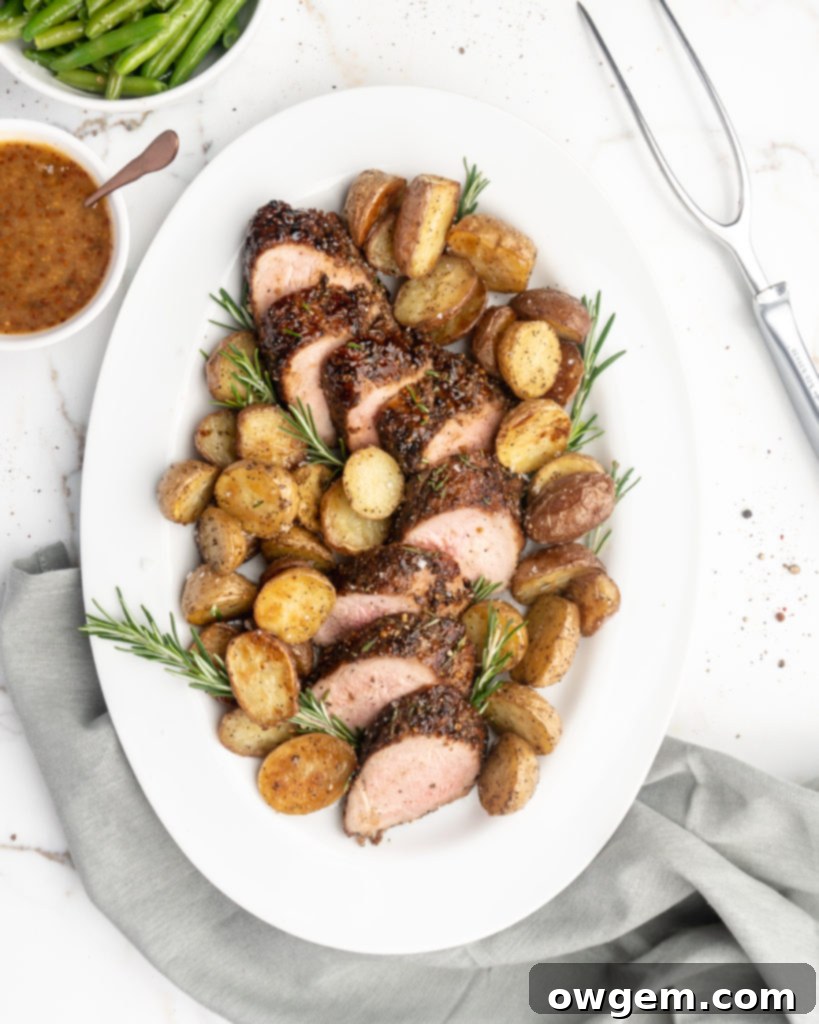
Serving Suggestions and Perfect Pairings
This Rosemary Peach Mustard Glazed Pork Tenderloin is a versatile dish that pairs beautifully with a variety of sides, making it easy to create a complete and satisfying meal. The sweet and tangy notes of the glaze complement both rich and fresh accompaniments. Consider serving it with roasted root vegetables like carrots and parsnips, which caramelize beautifully in the oven alongside the pork. Creamy mashed potatoes or a fluffy rice pilaf provide a comforting base to soak up any extra sauce. For a lighter touch, steamed green beans, asparagus, or a fresh garden salad with a simple vinaigrette would be excellent choices, adding a crisp contrast to the tender pork.
Don’t forget to drizzle extra reserved Peach Mustard over the sliced pork or offer it on the side for dipping. This amplifies the signature flavors and adds a visually appealing touch. A sprinkle of fresh parsley or a few extra rosemary sprigs can also enhance the presentation. This recipe is also wonderful for meal prep; the cooked pork can be sliced and stored in an airtight container with the sauce for quick lunches throughout the week. Reheat gently to maintain moisture. Leftovers make fantastic sandwiches or additions to salads.

Get the Recipe:
Pork Tenderloin with Peach Mustard
Pin
Rate
Ingredients
- 2 (1lb each) Pork Tenderloins
- 1 tsp Salt
- Lots of Freshly Cracked Black Pepper (about 1.5 – 2 tbsp)
- 1 tbsp Olive Oil
- 1/2 cup Peach Jam or Peach Preserves
- 2 tbsp Grainy Mustard
- 1 tbsp Dijon Mustard
- Zest of 1 Lemon
- 2 tsp Finely Chopped Fresh Rosemary
Instructions
-
Preheat your oven to 400°F (200°C). Evenly season the pork tenderloins with salt on all sides. Set them aside for 10 minutes; this allows the salt to penetrate and enhance the flavor of the meat. While the pork rests, prepare your peach mustard glaze: In a medium bowl, combine the peach jam (or preserves), grainy mustard, Dijon mustard, and the vibrant lemon zest. Mix thoroughly until all ingredients are well incorporated. Scoop out about one-third of this peach mustard mixture into a separate small bowl. To this smaller portion, stir in the finely chopped fresh rosemary. This rosemary-infused glaze is specifically for coating the pork before roasting, while the remaining plain peach mustard will be served on the side.
-
Heat 1 tablespoon of olive oil in a large, heavy, oven-safe skillet (cast iron works wonderfully) over medium-high heat until shimmering. While the skillet heats, generously roll the salted pork tenderloins in freshly cracked black pepper, ensuring they are evenly coated on all sides. Once the skillet is hot, carefully place the pepper-crusted tenderloins into the pan. Sear each tenderloin on all sides until a beautiful golden-brown crust develops, approximately 2-3 minutes per side. This crucial step creates deep savory flavors through the Maillard reaction.
-
Once seared, generously brush the pork tenderloins with the rosemary peach mustard glaze (the one with the chopped rosemary). Ensure an even coating. Immediately transfer the skillet to the preheated oven and continue to cook for approximately 15-20 more minutes, or until the internal temperature of the pork reaches 145°F (63°C) when measured with a meat thermometer inserted into the thickest part. Remove the skillet from the oven and allow the pork tenderloins to rest on a cutting board or back in the skillet for a minimum of 5 minutes before slicing. This resting period is essential for the juices to redistribute, ensuring maximum tenderness and moisture. Slice the pork into medallions and serve immediately with the remaining two-thirds of the plain peach mustard on the side for an extra burst of flavor.
